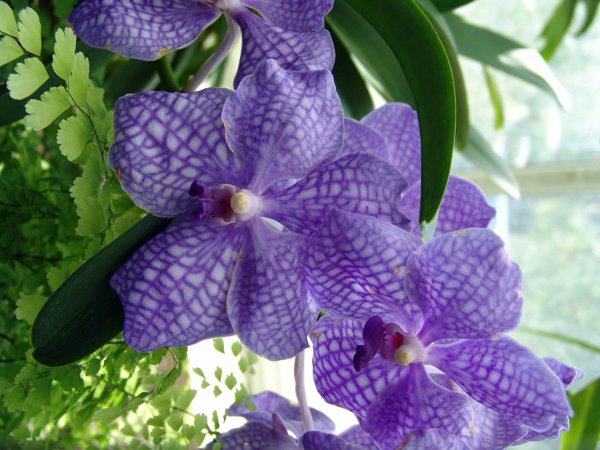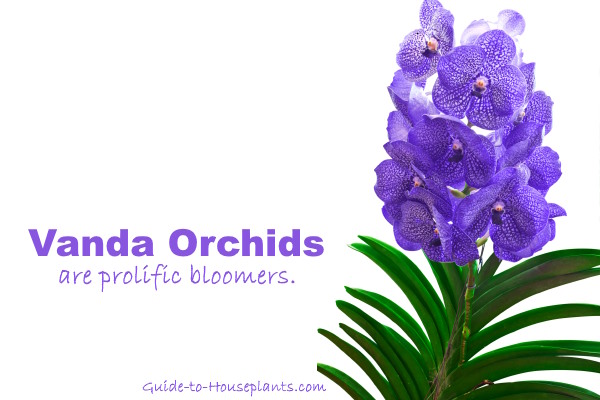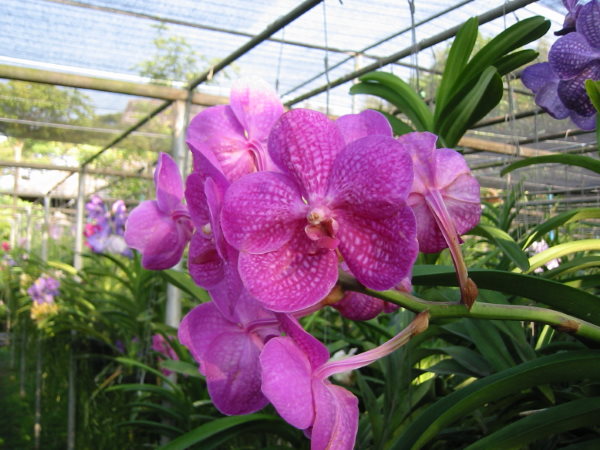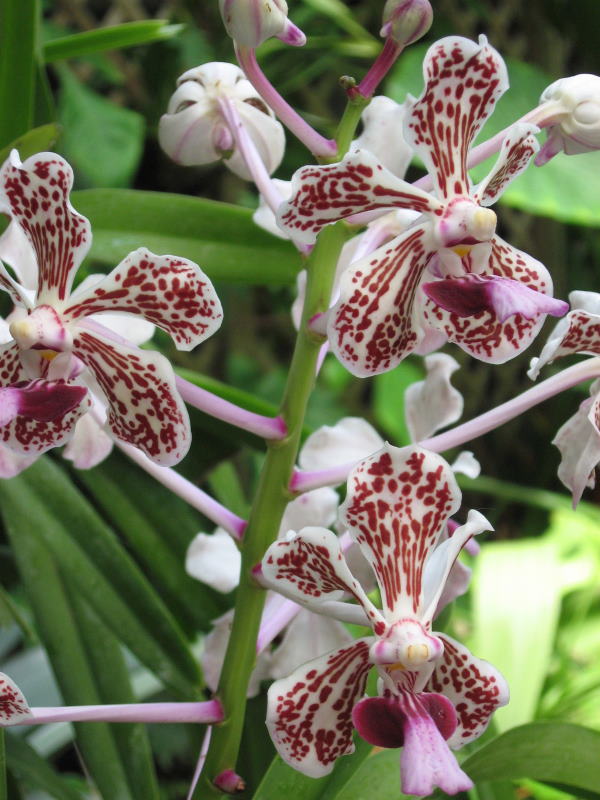Growing Vanda Orchid
Vanda orchid is highly prized for its brilliantly colored flowers that last for several weeks at a time. Give them what they want and some species may bloom 2 or 3 times a year.
Get orchid care tips and find out what type of light, water and humidity Vandas demand, plus what makes these beauties bloom.
 Brilliant hues of violet, purple, mauve and more -- make Vanda orchid capitvating to collectors.
Brilliant hues of violet, purple, mauve and more -- make Vanda orchid capitvating to collectors.Get to Know Vanda Orchids
Let's face it, unless you live in the tropics, Vanda orchid is a challenge to grow.
Why? It needs ample light year-round to make it grow and bloom. And that's not all. High humidity and good air circulation are essential.
Vandas are BIG plants with fanned-out foliage and long, draping roots...not your typical windowsill dwellers. Smaller hybrids, such as Vanda tricolor and compact Vanda coerulea are better suited for indoor growing.
Vanda orchids are monopodials (they grow from a single, upright stem) with long, strappy leaves fanning outward.
How big do they get? Vanda orchids can grow up to 3 ft (90 cm), depending on the variety.
You can expect flower spikes along the top part of the stem on mature plants. Vanda orchids can bloom any time of year, with the heaviest flowering in summer and autumn. They may bloom 2 or 3 times a year, as long as their needs are met. Bright daylight and cool nights will spark blooming.
Flower spikes grow from the stem, appearing from between every third leaf or so.
Both the petals and sepals are rounded and sport lines, splotches and dots in a contrasting color. The lip of many Vanda species are small and a solid color.

How to Grow Vanda Orchid Indoors
Vandas are epiphytes in their native tropical Asia habitats (they grow on tree branches). To imitate their native aerial lifestyle,
Vandas are often grown in a wood slat vanda orchid basket,
suspended so that the roots hang through the slats below.
Fill the basket with big chunks of fir bark,
coconut husks
or even wine corks to anchor a new plant. If you prefer, you can skip the medium entirely by
holding the plant in place with wire, just until its roots take hold of the basket.
Of course, this type of planting is only practical if you're growing them in a warm, humid greenhouse, where you can water or mist frequently and allow the excess water to drain freely.
For growing in the home, clay orchid pots work best. Vandas prefer clay pots to plastic because clay breathes, allowing air to get to the orchid's roots.
Use coarse fir bark as the medium to hold moisture around the roots while allowing air circulation.
Green Thumb Tip
Vanda orchid likes free-flowing air as in its native tree-dwelling habitat. Put it where it'll get plenty of air circulation. Fans are fine, but keep it away from heat/AC vents.
Vandas love humidity. Oh, boy...do they love humidity! Check the relative humidity with an indoor humidity gauge. If it drops below 60%, use a humidity tray or a cool-mist room humidifier. Grouping plants also helps to maintain the moisture in the air around them.
Wondering whether to repot? Repot your orchid every couple years because the medium will become compact. The best time to repot is when new growth begins, probably late winter or early spring.
 Warm-natured Vandas are at home in a greenhouse, bathed in humidity and bright light.
Warm-natured Vandas are at home in a greenhouse, bathed in humidity and bright light.Vanda Orchid Problems, Solutions and Answers
Problems with Vanda orchid are usually related to insufficient light and humidity or improper watering.
Limp or yellow leaves are often a symptom of overwatering. Remember Vanda's epiphytic nature: its roots are bathed in humidity and washed with rainwater, hanging in the open air. Aim to keep roots moist at all times, but not soggy which leads to root rot.
Brown spots on foliage can be scorch marks from direct sunlight or possibly leaf spot disease.
Something bugging your orchids? Watch for white, fuzzy mealybugs clustered along the flower stems or the base of leaves. Wipe them off with a damp cloth, then use an insecticide to control these damaging pests. Another common houseplant pest is aphids; they're attracted to new growth. Treat any infestation right away.
 One of the smaller varieties, Vanda Tricolor blooms abundantly on upright flower spikes.
One of the smaller varieties, Vanda Tricolor blooms abundantly on upright flower spikes.Buying Tips
The Vanda Alliance includes nearly 80 species and countless hybrids.
If you don't have a greenhouse, you'll find the miniature and compact hybrids easier to accommodate. Vanda cristata, Vanda coerulea and Vanda denisoniana are ideal for growing indoors.
Vanda Orchid Care Tips
Light: Vanda orchids are evergreen and require bright light year-round. Put your Vanda orchid where it'll get plenty of bright light, but out of direct sun. If you don't have a spot near a window, indoor plant lights will keep them from sulking, even through the winter months. Place orchids about 8 inches (20 cm) beneath the light for 14-16 hours a day. That allows several hours of darkness at night. Orchids need a rest, too.
Water: Vanda orchids need lots of moisture. How to water depends on how you're growing them. Large plants suspended from baskets have roots exposed to the air and will need watered daily. Mist or soak the roots in room-temperature water for about 20 minutes. Orchids grown in bark medium will stay moist longer. Water the medium thoroughly, then allow it to dry out a bit before watering again. Never allow the roots to dry out completely. Use rainwater or distilled water because tap water may contain fluoride and chlorine.
Humidity: High, preferably 60-80% relative humidity. It's a good idea to use a humidity tray or room humidifier. Get tips for raising indoor humidity.
Temperature: 70-85°F/21-29°C during the day, with a 15° drop in temperature at night to trigger flower buds. Vandas will tolerate a minimum nighttime temperature of 50°F/10°C.
Soil: Use coarse fir bark to hold moisture, while allowing air around the roots.
Fertilizer: Feed every 2 weeks with an orchid fertilizer while Vanda orchid is growing and blooming.
Propagation: Division of offsets


